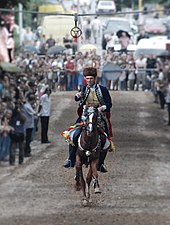Sinj
[4] Sinj is located in Dalmatia, in the region historically known as Cetinska Krajina, a group of settlements situated around a fertile karstic field of Sinjsko Polje (300 m AMSL), once shaped by the flood waters of the Cetina river.
They were settled in the area between the rivers of Krka and Cetina, where they clashed with the Romans in the period of wars from 156 BC to 9 AD, ending with their complete defeat under the leadership of Bato the Daesitiate.
The Byzantine Emperor Constantine VII mentions the County of Cetina among the Croatian administrative units in his 10th centuryDe Administrando Imperio.
It was ruled by the Talovci family beginning in the middle of the 15th century, followed by general discord and internal conflicts until it fell to the Ottoman Turks.
[5] With the return of power of the Republic of Venice to nearby Fortress of Klis in 1648, Sinj regained its old importance as the last Turkish outpost towards the Venetian possessions.
After several failed attempts to break free from Turkish rule, the new provisor Girolamo Cornaro with about 7,000 fighters[citation needed] captured the fortress on September 25, 1686.
Due to harsh living conditions and constant oppression under Ottoman rule, the domicile population declined, so Venetian authorities attempted to attract people from western Bosnia.
The siege was unsuccessful, owing primarily to the collapse of Ottoman logistics,[7] hunger and the outbreak of dysentery;[8] on the night of August 15, the Turks fled to Livno.
Contrary to popular belief, it appears that Venetian professional army units bore the majority of the burden in the conflict with Ottoman forces, rather than local fighters.
[5] With the defeat in the Battle of Austerlitz in 1805, Austria was forced to hand over all former Venetian possessions to Napoleon, giving the region a new master at the beginning of 1806.
After the Congress of Vienna in 1815 and until 1918, the town was part of the Austrian monarchy (Austria side after the compromise of 1867), head of the district of the same name, one of the 13 Bezirkshauptmannschaften in the Kingdom of Dalmatia.
[10] To get to know the newly acquired properties, Austrian Emperor Francis II takes a journey through Dalmatia in 1818, and visits Sinj.
The people of Sinj use the opportunity to organize the tournament of Alka, which Francis II liked so much that he established a permanent annual financial support.
The bridges over the Cetina river were built between 1849 and 1851; sewerage was installed in 1878, and by the end of the century, the town had taken on its current urban form; in 1891, an important tobacco trade center opened.
[11] In the famous Battle of the Neretva, nineteen-year-old Bruno Vuletić from Sinj commanded the 3rd Battalion of the 2nd Dalmatian Brigade, some of which were the first to cross the collapsed bridge and attack the Axis-aligned Chetniks.
[12] On April 22, 1945, Ante Bakotić from Sinj led the escape of male prisoners from the Jasenovac Concentration Camp, shortly before the end of WWII.
[15] The city was rapidly expanding through planned construction, which began with housing for workers at the newly established megafactory Dalmatinka; the town's Olympic swimming pool was built in parallel with the building of the factory.
[13][17] As of the 2021 census, the total population of the municipality was 23 452, distributed across the following settlements:[18] Sinj is well-known for Sinjska alka, a knights' tournament that is now on UNESCO Intangible Cultural Heritage List.
[3] Taking place in early August, it is a tourist attraction, and receives extensive media coverage and Croatia's political establishment attention.







